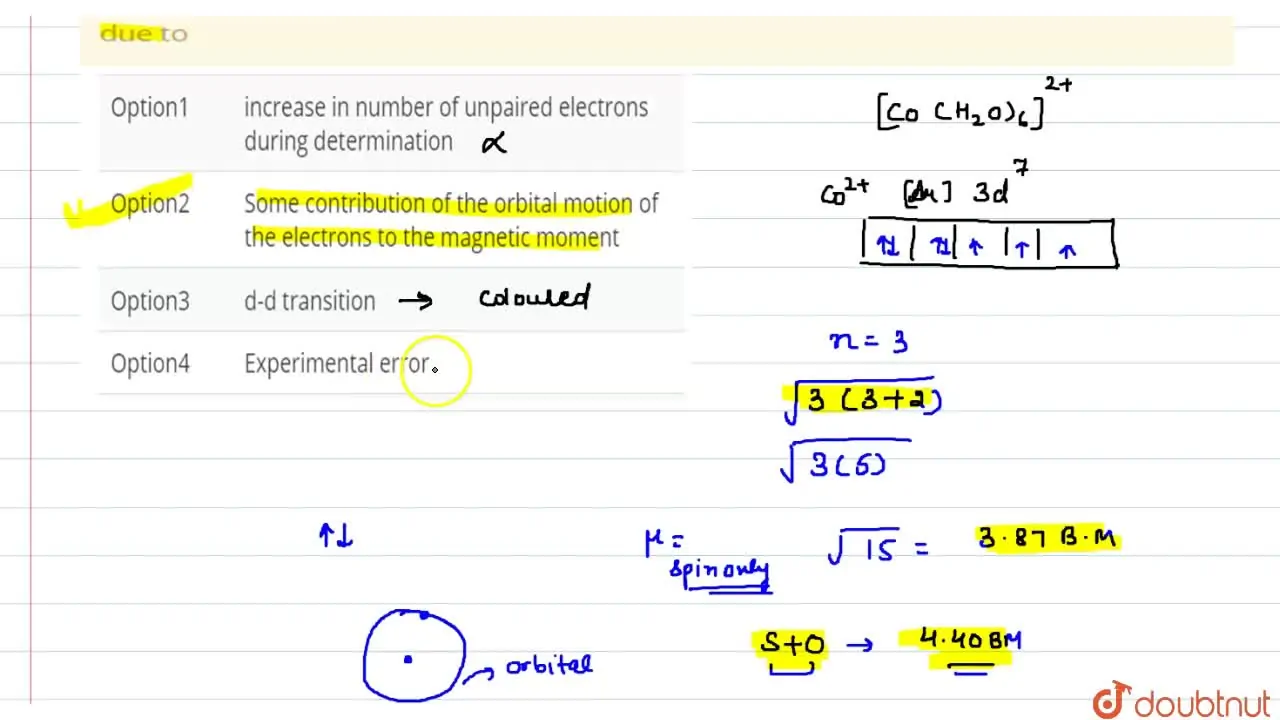Transition metals and many of their compounds show paramagnetic behaviour where there are unpaired electron or electrons. The magnetic moment arises from the spin and orbital motions in ions or molecule. Magnetic moment of n unpaired electrons is given as
μ=√n(n+2) Bohr magneton
Magnetic moment increases as the number of unpaired electrons increases.
Q. There are three unpaired electrons in [Co(H2O)6]2+ and calculated value of magnetic moment on the basis of √n(n+2) formula is 3.87 BM. which is lower than the expermental value of 4.40 BM. The reason for this difference is due to
increase in number of unpaired electrons during determination
Some contribution of the orbital motion of the electrons to the magnetic moment
d-d transition
Experimental error
The correct Answer is:b
Step by step video & image solution for Transition metals and many of their compounds show paramagnetic behaviour where there are unpaired electron or electrons. The magnetic moment arises from the spin and orbital motions in ions or molecule. Magnetic moment of n unpaired electrons is given as mu=sqrt(n(n+2)) Bohr magneton Magnetic moment increases as the number of unpaired electrons increases. Q. There are three unpaired electrons in [Co(H_2O)_6]^(2+) and calculated value of magnetic moment on the basis of sqrt(n(n+2)) formula is 3.87 BM. which is lower than the expermental value of 4.40 BM. The reason for this difference is due to by Chemistry experts to help you in doubts & scoring excellent marks in Class 12 exams.
Related Playlists
- BOOK - CENGAGE CHEMISTRY ENGLISHCHAPTER - D AND F BLOCK ELEMENTSEXERCISE - Exercises Multiple Correct28videos
D AND F BLOCK ELEMENTS
- BOOK - CENGAGE CHEMISTRY ENGLISHCHAPTER - D AND F BLOCK ELEMENTSEXERCISE - Exercises Single Correct D-Block Elements (General Properties And Electronic Configuration)15videos
D AND F BLOCK ELEMENTS
- BOOK - CENGAGE CHEMISTRY ENGLISHCHAPTER - D AND F BLOCK ELEMENTSEXERCISE - Ex 6.2 Subjective (Compound Of Hg:)3videos
D AND F BLOCK ELEMENTS
- BOOK - CENGAGE CHEMISTRY ENGLISHCHAPTER - COORDINATION COMPOUNDSEXERCISE - Archives Subjective18videos
COORDINATION COMPOUNDS
- BOOK - CENGAGE CHEMISTRY ENGLISHCHAPTER - ELECTROCHEMISTRYEXERCISE - Archieves Subjective35videos
ELECTROCHEMISTRY
Similar Questions
Transition metals and many of their compounds show paramagnetic behaviour where there are unpaired electron or electrons. The magnetic moment arises from the spin and orbital motions in ions or molecule. Magnetic moment of n unpaired electrons is given as
μ=√n(n+2) Bohr magneton
Magnetic moment increases as the number of unpaired electrons increases.
Q. In 3d series the maximum magnetic moment is shown byView SolutionTransition metals and many of their compounds show paramagnetic behaviour where there are unpaired electron or electrons. The magnetic moment arises from the spin and orbital motions in ions or molecule. Magnetic moment of n unpaired electrons is given as
μ=√n(n+2) Bohr magneton
Magnetic moment increases as the number of unpaired electrons increases.
Q. Which among the following ions has maximum value of magnetic momentView SolutionTransition metals and many of their compounds show paramagnetic behaviour where there are unpaired electron or electrons. The magnetic moment arises from the spin and orbital motions in ions or molecule. Magnetic moment of n unpaired electrons is given as
μ=√n(n+2) Bohr magneton
Magnetic moment increases as the number of unpaired electrons increases.
Q. Magnetic moment of [Ni(CN)4]2− is zero but that of [Ni(H2O)4]2+ is 2.83BM. is because of :View SolutionTransition metals and many of their compounds show paramagnetic behaviour where there are unpaired electron or electrons. The magnetic moment arises from the spin and orbital motions in ions or molecule. Magnetic moment of n unpaired electrons is given as
μ=√n(n+2) Bohr magneton
Magnetic moment increases as the number of unpaired electrons increases.
Q. Magnetic moments of Cr(Z=24),Mn⊕(Z=35) and Fe2+(Z=36) are x,y and z respectively. Which of the following order is correct?View SolutionThe number of unpaired electron in Ni2+ is
View SolutionThe number of unpaired electron in Cr+2 is
View SolutionThe number of unpaired electrons in Zn2+ is
View SolutionThe number of unpaired electrons in O2 is ……
View SolutionState the number of unpaired electrons in Ni2+ :
View SolutionThe number of unpaired electrons in Zn element is
View Solution


